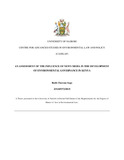| dc.description.abstract | The influence that news media reporting brings to bear on the process of environmental governance is one that is arguably difficult to lucidly illustrate. This relationship can be obscure at times, with no clear lines of demarcation in direction of causality and effect. Despite this, there is a clear upward trend in volume of media coverage. The emergence of nascent communication technology tools coupled with the unprecedented rate of global connectivity, have bolstered the pace and reach of environmental news, including active media coverage of the occurrence of environmental events–magnitude notwithstanding.
From media interviews with communities affected by lead poisoning in Owino Uhuru in Mombasa, to impactful spatial images of vast swathes of forest land degraded by human encroachment aired alongside drastic tales of patterns of land-use change in the Mau Forest Complex, and even to the more familiar Maathai-led protests to protect public spaces from private development, Kenya’s fourth estate continues to play the unique intermediary role of conveyor of public information and catalyzer of societal engagement on environmental issues.
Considering environmental actors – state, non-state actors and the general public as the primary recipients of media reports – this research integrated principles of public participation and environmental democracy to analyze the reception, interpretation and response of media coverage in the target audience. This thesis critically examined the volume and quality of environmental news coverage in Kenya over a five year period using statistical and content analysis methods. Multivariate regression analysis was then applied to evaluate the strength of the effect of two selected predictor variables; public participation and volume of thematic environmental coverage on the level of stringency in environmental policy (SEP). Weighted Kenya-country data drawn from the Environmental Performance Index (EPI) constituted the basis for the predicted variable. The EPI is a biennial index that contains indicators on environmental policy performance. These indicators are developed by “proximity-to-target” design, where a top performance benchmark, is defined primarily by 2 variables: policy goals at the international or national levels or established
scientific thresholds. The result was a strong positive linear association between the three variables.
Based on the output results, 49% of the variation in the predicted variable - Stringency in Environmental Policy (SEP) can be explained using the two predictor variables of public participation and thematic media coverage. This analysis is statistically useful and provides a model that can be replicated in future similar studies to explain 49% of the values. Otherwise put, 49% of observed levels of stringency in environmental policy (SEP) could be the result of a combination of effective public participation and corresponding media issue dominance.
In addition to the statistical model and three case studies included in this thesis, a survey of environmental journalists was conducted to better understand the underlying drivers of environmental news coverage from a media operations perspective. According to the poll, coverage of an environmental-related news or features was dependent on editorial decisions with 47% of respondents stating that such news would only be aired or published if no other ‘seemingly competitive’ news were available.
Based on the data outcomes, this thesis makes three key policy recommendations that can be implemented in the short-term, medium and long-term: Media capacity building through the Ministry of Environment, re-tooling regulatory policies communications through NEMA and lastly, active media monitoring of environmental coverage by key actors in environmental governance processes. | en_US |



